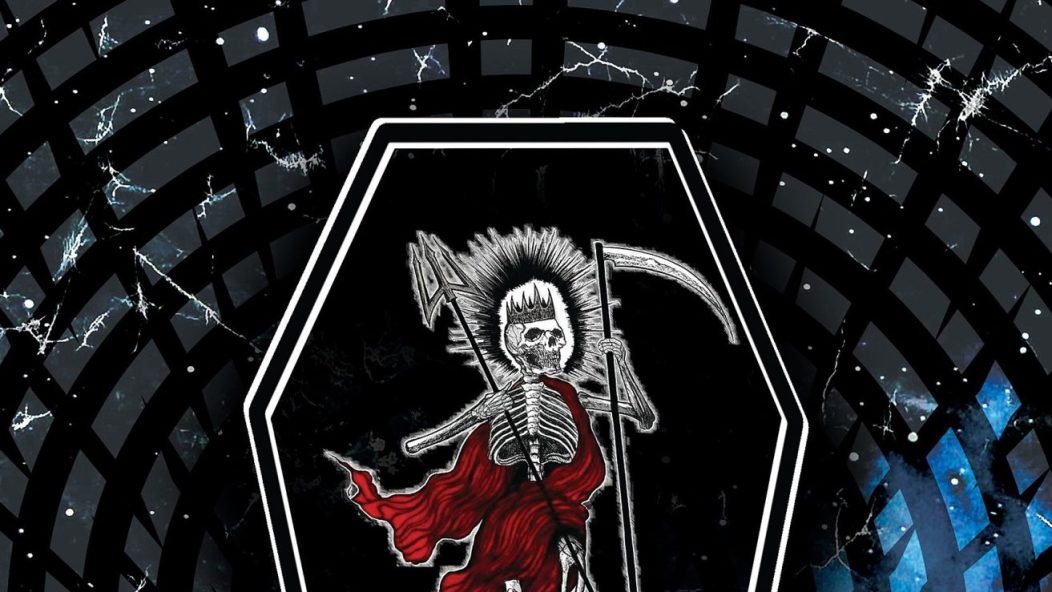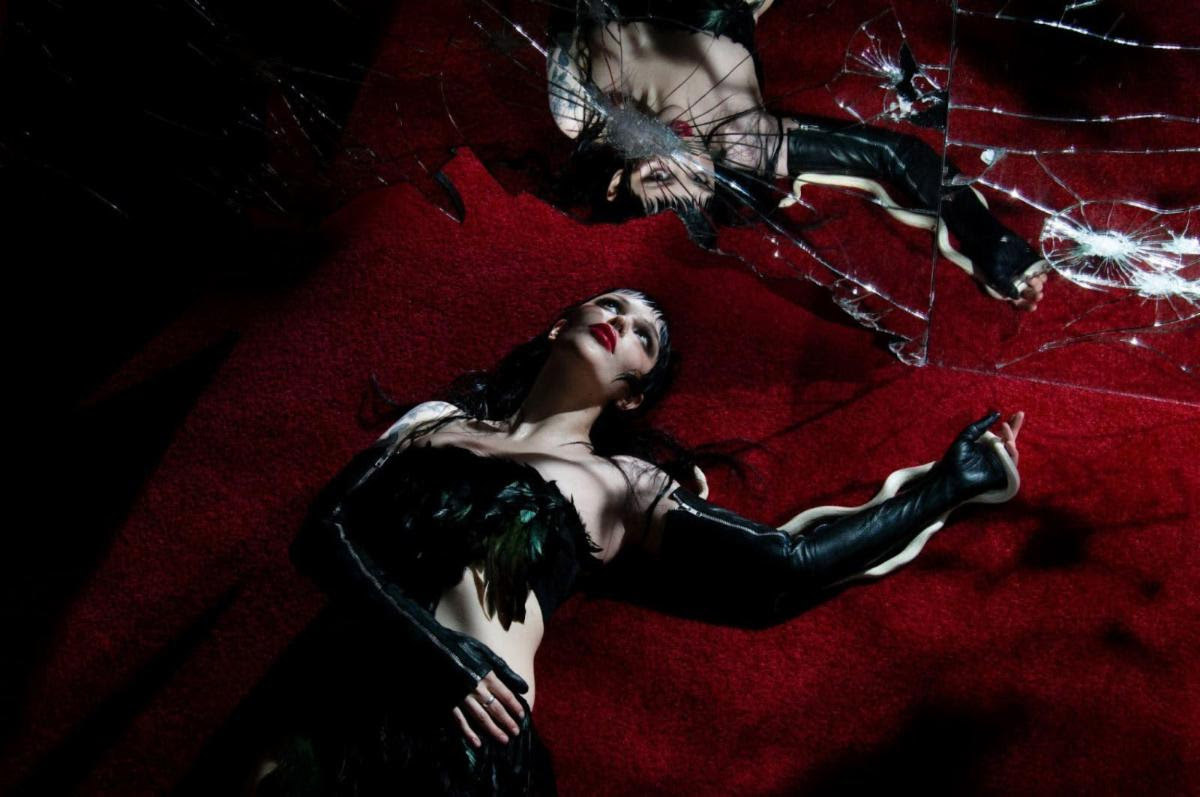
Blackened Literature: Castaigne Publishing Ventures into Black Metal Horror Anthologies (Review + Interview)
It seems obvious, stated out loud: black metal music and horror literature are natural bedfellows. The shared interests abound, from death, gore, and darkness to Satanism, subversion of Christianity, and destruction of social norms. Despite the ever-encroaching Venn diagram, relatively few crossovers exist in any media. The documentary Until the Light Takes Us and feature film Lords of Chaos are the clearest film examples, with some arguments to be made for movies like The Witch, Antichrist, and even Haxan. In print media, the landscape is even more scant–which is where hyper-indie small press Castaigne Publishing and their recent black metal horror anthologies come in.
In the Shadow of the Horns and Into the Crypts of Rays are full-frontal additions to the black metal canon, no bones about it. Emerging swiftly–volume one was published in October 2021 and volume two in May 2022–and taking no prisoners, these anthologies stand apart even within the current indie horror community. The tables of contents are studded with rising stars of the gorehound literati, such as Joe Koch and fellow writer-publisher Sam Richard of Weirdpunk Books; the stories contained within are as confrontational, ugly, transcendent, boundary-pushing, and occasionally blinkered as the scene they’re exploring. Horror as a literary and film genre has undergone interrogation, backlash, and continual expansion since its inception, remaining equally maligned and beloved by fans, critics, creators, and culture. Similarly, black metal has developed in resistance both to its enveloping societies and genre norms of the heavy metal umbrella.
One of black metal’s particular hallmarks is a commitment to the underground, and Castaigne’s anthologies are no exception. The two books were both released in limited print runs, without ebook availability, and unavailable for purchase anywhere other than the publisher’s online shop; In the Shadow of the Horns is out of print, and a limited stock of Into the Crypts of Rays remains (although there’s also a “cvlt” edition accompanied by a split vinyl and assorted extra goodies). These intentional restrictions might limit the eyes on each book, but the editors consider that a feature, not a bug–sonically, black metal isn’t for everyone, and in terms of literature, even horror aficionados might look askance at some of the material in the Castaigne anthologies. Experimental forms and extreme narratives abound; black metal’s archetypes appear one by one. The Satan of bands like Kafirun and Lathspell looms large, multiformed, and eye-searing in “For this Divinity” by C. Bridh Blanchard and Joe Koch’s gender-bending ode to Luciferianism “Leviathan’s Knot.” Mythic histories and atmospheric landscapes reminiscent of Carpathian Forest and Fluisteraars are brought to life in Sam Richard’s “Taken by the Mountains” and the opening volley of Into the Crypts of Rays, “The Charge” by Solomon Forse. For fans of the visual, comics also appear alongside short fiction, black-and-white art providing corpse paint for interior art.
Both horror and black metal operate beyond the pale, a position that sometimes produces, at best, mixed results and at worst, homophobia, misogyny, and white supremacy. All the same, both subcultures have adherents, critics, and makers who are not, let’s say, always the target audience. Each book is framed by an introduction, and although neither seems too interested in interrogating how black metal functions in the current day, perhaps that’s for the best: the impact is all the more profound and disturbing when stories such as Koch’s two forays into genderfuckery and Katie Steinrick’s erotic grotesquerie land. The inclusion of trans authors, female authors, and authors of color paints a blood-red sign for bigots to steer clear. What’s more, the unbounded imagination and unexpected perspectives on display in Castaigne’s anthologies mirrors the explosion of groundbreaking black metal acts operating currently; these books pair well with artists like Blackbraid, Ethereal Credence, and Yovel. It’s obvious that each book’s contributors know their stuff, straddling their genres’ sometimes-goofy lines to deliver stories that–for all their outre characters and outlandish plots–are written from deep hearts, spry brains, and wicked senses of humor. Gory or glorious, cosmic or comic, black metal’s manifold appeal and multicultural occurrence are on full display in these anthologies.
We chatted briefly with Evan Dean Shelton and Edwin Callihan, co-editors and publishers at Castaigne.
–Dee Holloway
…
Hello, Evan and Edwin! Please tell us a bit about yourselves and how Castaigne Publishing came into existence.
EDS: Howdy! I’m Evan Dean Shelton. I’m a storyteller, occult practitioner, adventurer, outlaw, and buffoon. Castaigne Publishing came about because we saw so many people putting out goofy-ass themed horror anthologies that we said “We could do this.”
EC: Hey. I’m Edwin Callihan. I dabble in a little bit of everything. I write comics and fiction, paint, draw, etc. I run an indie bookshop. I hoard massive amounts of shit from books, zines, vhs, records, tapes, skulls, and anything I deem fit for my collection of the macabre and weird.
The behemoth in the room: what prompted an anthology at the crossroads of black metal and horror?
Both of us are black metal fans and artists, and horror writers. The two topics are bouncing around our heads daily. It was our first idea, and when we talked about it we realized what a broad spectrum of themes it covers, from Death and The Devil…to nihilism, antinatalism, misanthropy, cosmic horror, occult horror…so many themes. It’s rich ground to grow horrors from.
How did the tables of contents for each anthology develop? Did either or both books have a unifying theme or element beyond the black metal-horror Great Marriage?
The first book is thematically centered around Satan, the second book is Death. To us, these are the core ideas of black metal. These themes came together completely organically, after we had chosen submissions. There are no coincidences. We put a lot of thought into the order of stories in the table of contents, the same way we would the songs on an album we worked on. There’s a dynamic pacing, and a carefully curated trilogy at the end of each book that we hope serves as a big finish to readers.
Horror and black metal are two genres that have seen numerous waves of backlash and expansion. Were the politics of these genres in your minds while assembling the stories collected in these anthologies?
Neither of us are into politics, and we tend to avoid work that comes off as “preachy”, but we’re sure some readers will find plenty along those lines to think about in these books. We just chose stories that we loved, that we felt really nailed the themes we were looking for.
Castaigne published these two books in a limited print run, with no ebooks available through the publisher shop or booksellers–which is a bit unusual in the current media landscape of instant access and ephemeral impact. What were your priorities and expectations with this style of publication?
Our expectations are meager and humble, haha. We’re just doing our thing, hoping to keep it in the black, and to help curate and print some killer independent work, to help amplify voices and do something different. We expect to grow and to be able to offer more. Our approach is to keep things stripped down and as middle-man free as possible. Castaigne is just the two of us and our printer, which is a local printer in Kentucky where Edwin lives. We make books and sell books. We will never be associated with Amazon or any of its subsidiaries. We don’t do print on demand, we don’t put barcodes on our books. We’re true independent publishers. Purveyors of graphic fantasy and nightmare. It’s just the creators, us, and you.
Do either of you make music in addition to writing and editing prose? If so, how does your musical practice inflect your writing, and vice versa?
Evan is a member of black metal coven Grave Gnosis, and ritual noise group Bound For The Ground. Edwin is a member of black metal group TERROR NOSFERATU PROPAGANDA, and dungeon synth group Shambler.
Neither of us find any distinction between the art of storytelling with sound, or with words. Each is greatly informed by the other.
Besides In the Shadow of the Horns and Into the Crypts of Rays, what’s the most metal (black or otherwise) book in Castaigne’s catalogue?
The Lurking Transmission: Grimoire I is a very black metal book, as it’s a printed translation of planet earth’s only black metal and horror fiction podcast. It’s full of stories and illustrations and sigils and evil.
Talk about some of your favorite horror media and/or black metal bands and albums.
EDS: I love a podcast called The Wrong Station. Every story is unique and thought provoking, and the main narrator is phenomenal. There have been some killer black metal albums released this year. Top of the heap for me are Watain, Lifvsleda, and Acherontas. These are also three of my favorite black metal bands so that checks out, haha. Lifvsleda are a new band but they’re so damn good, top-tier status for me with only two albums and a few smaller releases. That good.
EC : I love horror magazines from the pulp stuff to splatterpunk era like Midnight Graffiti and all the zines of the 90s. More contemporary; I really dig authors like Curtis Lawson, Matt Cardin, and John Wayne Comunale. As far as black metal, Evilfeast, Necrostrigis, Crimson Moon. I’m a simple man. I don’t venture much out in much that is current.
Is there a third black metal horror book in the offing? What’s up next for Castaigne?
We don’t have a third black metal book planned, but who knows what the future may bring… Up next we have Lockdown Laureate, by OF Cieri–a graffiti occulted street grimoire of weird tales and gorgeous artwork.











